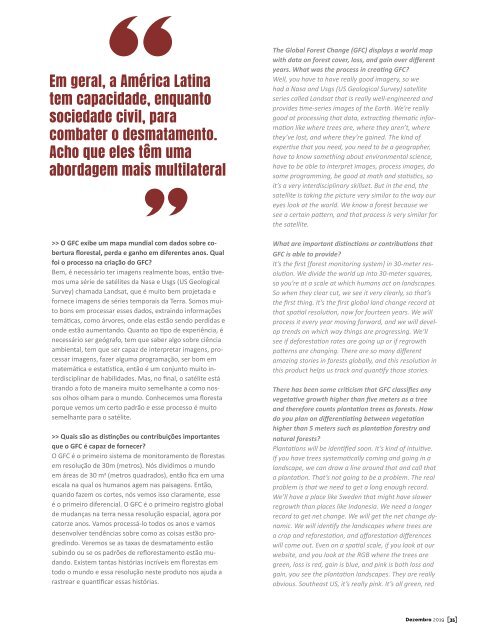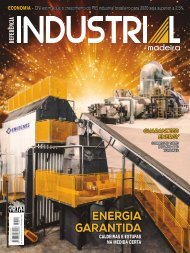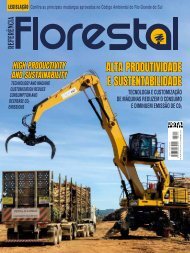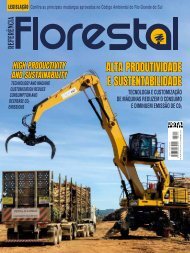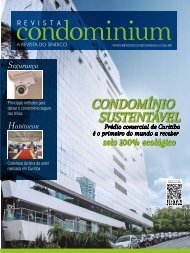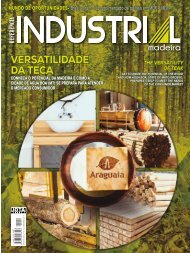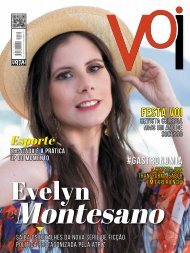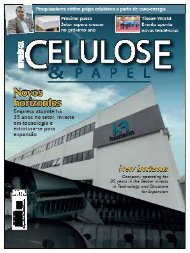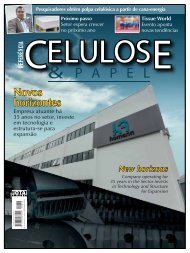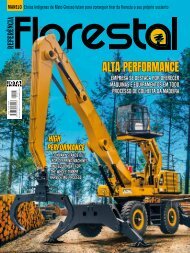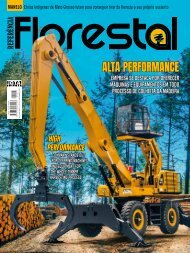You also want an ePaper? Increase the reach of your titles
YUMPU automatically turns print PDFs into web optimized ePapers that Google loves.
Em geral, a América Latina<br />
tem capacidade, enquanto<br />
sociedade civil, para<br />
combater o desmatamento.<br />
Acho que eles têm uma<br />
abordagem mais multilateral<br />
>> O GFC exibe um mapa mundial com dados sobre cobertura<br />
florestal, perda e ganho em diferentes anos. Qual<br />
foi o processo na criação do GFC?<br />
Bem, é necessário ter imagens realmente boas, então tivemos<br />
uma série de satélites da Nasa e Usgs (US Geological<br />
Survey) chamada Landsat, que é muito bem projetada e<br />
fornece imagens de séries temporais da Terra. Somos muito<br />
bons em processar esses dados, extraindo informações<br />
temáticas, como árvores, onde elas estão sendo perdidas e<br />
onde estão aumentando. Quanto ao tipo de experiência, é<br />
necessário ser geógrafo, tem que saber algo sobre ciência<br />
ambiental, tem que ser capaz de interpretar imagens, processar<br />
imagens, fazer alguma programação, ser bom em<br />
matemática e estatística, então é um conjunto muito interdisciplinar<br />
de habilidades. Mas, no final, o satélite está<br />
tirando a foto de maneira muito semelhante a como nossos<br />
olhos olham para o mundo. Conhecemos uma floresta<br />
porque vemos um certo padrão e esse processo é muito<br />
semelhante para o satélite.<br />
>> Quais são as distinções ou contribuições importantes<br />
que o GFC é capaz de fornecer?<br />
O GFC é o primeiro sistema de monitoramento de florestas<br />
em resolução de 30m (metros). Nós dividimos o mundo<br />
em áreas de 30 m2 (metros quadrados), então fica em uma<br />
escala na qual os humanos agem nas paisagens. Então,<br />
quando fazem os cortes, nós vemos isso claramente, esse<br />
é o primeiro diferencial. O GFC é o primeiro registro global<br />
de mudanças na terra nessa resolução espacial, agora por<br />
catorze anos. Vamos processá-lo todos os anos e vamos<br />
desenvolver tendências sobre como as coisas estão progredindo.<br />
Veremos se as taxas de desmatamento estão<br />
subindo ou se os padrões de reflorestamento estão mudando.<br />
Existem tantas histórias incríveis em florestas em<br />
todo o mundo e essa resolução neste produto nos ajuda a<br />
rastrear e quantificar essas histórias.<br />
The Global Forest Change (GFC) displays a world map<br />
with data on forest cover, loss, and gain over different<br />
years. What was the process in creating GFC?<br />
Well, you have to have really good imagery, so we<br />
had a Nasa and Usgs (US Geological Survey) satellite<br />
series called Landsat that is really well-engineered and<br />
provides time-series images of the Earth. We’re really<br />
good at processing that data, extracting thematic information<br />
like where trees are, where they aren’t, where<br />
they’ve lost, and where they’re gained. The kind of<br />
expertise that you need, you need to be a geographer,<br />
have to know something about environmental science,<br />
have to be able to interpret images, process images, do<br />
some programming, be good at math and statistics, so<br />
it’s a very interdisciplinary skillset. But in the end, the<br />
satellite is taking the picture very similar to the way our<br />
eyes look at the world. We know a forest because we<br />
see a certain pattern, and that process is very similar for<br />
the satellite.<br />
What are important distinctions or contributions that<br />
GFC is able to provide?<br />
It’s the first [forest monitoring system] in 30-meter resolution.<br />
We divide the world up into 30-meter squares,<br />
so you’re at a scale at which humans act on landscapes.<br />
So when they clear cut, we see it very clearly, so that’s<br />
the first thing. It’s the first global land change record at<br />
that spatial resolution, now for fourteen years. We will<br />
process it every year moving forward, and we will develop<br />
trends on which way things are progressing. We’ll<br />
see if deforestation rates are going up or if regrowth<br />
patterns are changing. There are so many different<br />
amazing stories in forests globally, and this resolution in<br />
this product helps us track and quantify those stories.<br />
There has been some criticism that GFC classifies any<br />
vegetative growth higher than five meters as a tree<br />
and therefore counts plantation trees as forests. How<br />
do you plan on differentiating between vegetation<br />
higher than 5 meters such as plantation forestry and<br />
natural forests?<br />
Plantations will be identified soon. It’s kind of intuitive.<br />
If you have trees systematically coming and going in a<br />
landscape, we can draw a line around that and call that<br />
a plantation. That’s not going to be a problem. The real<br />
problem is that we need to get a long enough record.<br />
We’ll have a place like Sweden that might have slower<br />
regrowth than places like Indonesia. We need a longer<br />
record to get net change. We will get the net change dynamic.<br />
We will identify the landscapes where trees are<br />
a crop and reforestation, and afforestation differences<br />
will come out. Even on a spatial scale, if you look at our<br />
website, and you look at the RGB where the trees are<br />
green, loss is red, gain is blue, and pink is both loss and<br />
gain, you see the plantation landscapes. They are really<br />
obvious. Southeast US, it’s really pink. It’s all green, red<br />
Dezembro <strong>2019</strong><br />
35


